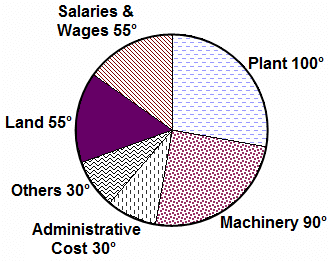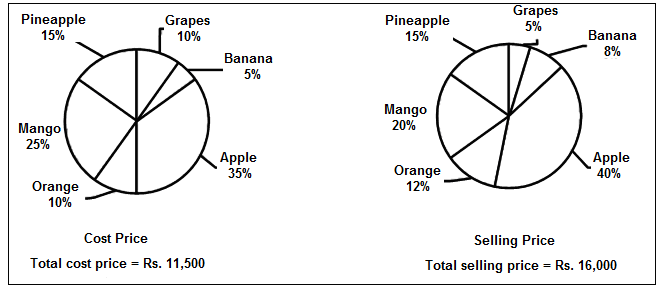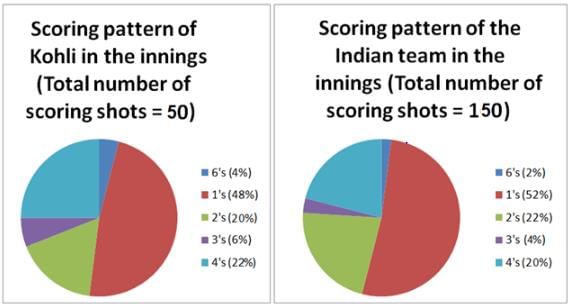CAT Practice Test: August 18 - CAT MCQ
30 Questions MCQ Test - CAT Practice Test: August 18
In an examination, A gets 40% of the total marks and B gets 80% of that of A. C gets 60% of A's and B's marks taken together. D gets 45% of A's and C's marks taken together. If the required passing marks are 36%, how many of these four students passed the examination?
Mr. Raj was throwing a party to his friends and he required 37 kg of sweets for that. Assuming 19% wastage and knowing that the sweets were available in 2 kg packets only, what would be the approximate cost of the sweets purchased if one packet cost Rs. 150?
A and B are two numbers such that, B – A = P (where P ≠ 0) and B = P% more than A. Find B.
In a fraction X, if thrice the denominator is decreased by 30% and twice the numerator is increased by 10%, then the resultant fraction is 22% of 26/21. Find the fraction X.
If x varies inversely as y3 – 1 and is equal to 3 when y = 2, find x when y = 4.
If 10 men working 6 hours a day can do a piece of work in 15 days, in how many days will 20 men working 14 hours a day do the same work?
Directions: Study the following information and answer the question that follows.
The table below represents the number of software projects on different domains that were done in different companies in 2006.

There were no other projects done by these companies, except those given above.
In 2005, the number of projects of each company was 20% less than that in 2006, how many companies got at the most 30 projects in 2005?
Directions: Study the following information and answer the question that follows.
The table below represents the number of software projects on different domains that were done in different companies in 2006.

There were no other projects done by these companies, except those given above.
How many companies did less Java projects than Birlasoft in 2006?
Directions: Refer to the table below and answer the following question.
The table gives the terms of subscriptions for a magazine.

Conditions:
1. If you subscribe for 1–3 years, postage = Rs. 50 per year of subscription.
2. For a subscription of 3 years, you receive a gift worth Rs. 300.
3. For a subscription of 4 years, you receive a special gift worth Rs. 500.
4. For a subscription of 5 years, you get additional 12 issues for the 6th year, as a special gift.
5. Effective cost = Special Offer Price – Cost of gifts + Cost of postage
The % decrease in Special Offer Price per issue from one term to the next is maximum for
Directions: Refer to the table below and answer the following question.
The table gives the terms of subscriptions for a magazine.

Conditions:
1. If you subscribe for 1–3 years, postage = Rs. 50 per year of subscription.
2. For a subscription of 3 years, you receive a gift worth Rs. 300.
3. For a subscription of 4 years, you receive a special gift worth Rs. 500.
4. For a subscription of 5 years, you get additional 12 issues for the 6th year, as a special gift.
5. Effective cost = Special Offer Price – Cost of gifts + Cost of postage
What is the approximate difference in the effective cost per issue between a subscription for 2 years and subscription for 5 years?
Directions: Refer to the table below and answer the following question.
The table gives the terms of subscriptions for a magazine.

Conditions:
1. If you subscribe for 1–3 years, postage = Rs. 50 per year of subscription.
2. For a subscription of 3 years, you receive a gift worth Rs. 300.
3. For a subscription of 4 years, you receive a special gift worth Rs. 500.
4. For a subscription of 5 years, you get additional 12 issues for the 6th year, as a special gift.
5. Effective cost = Special Offer Price – Cost of gifts + Cost of postage
The Special Offer Price as a percentage of News Stand Price is minimum for which subscription?
Directions: Refer to the table below and answer the following question.
The table gives the terms of subscriptions for a magazine.

Conditions:
1. If you subscribe for 1–3 years, postage = Rs. 50 per year of subscription.
2. For a subscription of 3 years, you receive a gift worth Rs. 300.
3. For a subscription of 4 years, you receive a special gift worth Rs. 500.
4. For a subscription of 5 years, you get additional 12 issues for the 6th year, as a special gift.
5. Effective cost = Special Offer Price – Cost of gifts + Cost of postage
What is the ratio of Effective Price to News Stand Price per issue, for a subscription of 4 years?
Directions: Answer the question based on the data provided in the table given below:

Asset Utilisation Factor (AUF) = Sales value/Assets
Worker productivity = Production of units/Number of workers
Assume that whatever was produced in a given year was sold in the same year.
All sales were of produced units only.
In which year was worker productivity the highest?
Directions: The question is based on the following pie chart.
Project implementation cost of ABC Ltd. (Rs. Crores)
Total project cost = Rs. 252 Crores

If there is an escalation of 10% in Salaries& Wages and a reduction of 10% in land, what will be the new angle of salaries and wages?
Directions: The question is based on the following pie chart.
Project implementation cost of ABC Ltd. (Rs. Crores)
Total project cost = Rs. 252 Crores

If 5% of administrative costs are reduced and 10% of the remaining administrative costs are transferred to Others category, what is the angle of administrative costs now?
Directions: The following diagrams show the cost price and selling price (in Rs.) of different fruits sold by a fruit vendor.

If the selling price of pineapple is increased by 20%, then what is the percentage increase in the total selling price?
Directions: Answer the question on the basis of the pie charts given below.
The following pie charts show the distribution of run scored by Kohli and the Indian team in an innings, considering only the scoring shots.

- The balls on which no runs were scored are called dot balls.
- Strike rate of a batsman is the number of runs scored as the percentage of the total number of balls played, including the dot balls.
If Kohli played 98 dot balls, what was his approximate strike rate?
Directions: Answer the question on the basis of the pie charts given below.
The following pie charts show the distribution of run scored by Kohli and the Indian team in an innings, considering only the scoring shots.

- The balls on which no runs were scored are called dot balls.
- Strike rate of a batsman is the number of runs scored as the percentage of the total number of balls played, including the dot balls.
What was Kohli's share in the number of 4s scored by the Indian team?
The four sentences (labelled 1, 2, 3, 4) below, when properly sequenced would yield a coherent paragraph. Decide on the proper sequencing of the order of the sentences and key in the sequence of the four numbers as your answer:
1. But the attention of the layman, not surprisingly, has been captured by the atom bomb, although there is at least a chance that it may never be used again.
2. Of all the changes introduced by man into the household of nature, [controlled]large-scale nuclear fission is undoubtedly the most dangerous and most profound.
3. The danger to humanity created by the so-called peaceful uses of atomic energy may, however, be much greater.
4. The resultant ionizing radiation has become the most serious agent of pollution of the environment and the greatest threat to man’s survival on earth.
The four sentences (labelled 1, 2, 3, 4) below, when properly sequenced would yield a coherent paragraph. Decide on the proper sequencing of the order of the sentences and key in the sequence of the four numbers as your answer:
1. Each one personified a different aspect of good fortune.
2. The others were versions of popular Buddhist gods, Hindu gods and Daoist gods.
3. Seven popular Japanese deities, the Shichi Fukujin, were considered to bring good luck and happiness.
4. Although they were included in the Shinto pantheon, only two of them, Daikoku and Ebisu, were indigenous Japanese gods.
The four sentences (labelled 1, 2, 3, 4) below, when properly sequenced would yield a coherent paragraph. Decide on the proper sequencing of the order of the sentences and key in the sequence of the four numbers as your answer:
1. Complex computational elements of the CNS are organized according to a “nested” hierarchic criterion; the organization is not permanent and can change dynamically from moment to moment as they carry out a computational task.
2. Echolocation in bats exemplifies adaptation produced by natural selection; a function not produced by natural selection for its current use is exaptation --feathers might have originally arisen in the context of selection for insulation.
3. From a structural standpoint, consistent with exaptation, the living organism is organized as a complex of “Russian Matryoshka Dolls” -- smaller structures are contained within larger ones in multiple layers.
4. The exaptation concept, and the Russian-doll organization concept of living beings deduced from studies on evolution of the various apparatuses in mammals, can be applied for the most complex human organ: the central nervous system (CNS).
The four sentences (labelled 1, 2, 3, 4) given below, when properly sequenced would yield a coherent paragraph. Decide on the proper sequence of the order of the sentences and key in the sequence of the four numbers as your answer.
1. People with dyslexia have difficulty with print-reading, and people with autism spectrum disorder have difficulty with mind-reading.
2. An example of a lost cognitive instinct is mind-reading: our capacity to think of ourselves and others as having beliefs, desires, thoughts and feelings.
3. Mind-reading looks increasingly like literacy, a skill we know for sure is not in our genes, since scripts have been around for only 5,000-6,000 years.
4. Print-reading, like mind-reading varies across cultures, depends heavily on certain parts of the brain, and is subject to developmental disorders.
The four sentences (labelled 1, 2, 3, 4) given below, when properly sequenced would yield a coherent paragraph. Decide on the proper sequence of the order of the sentences and key in the sequence of the four numbers as your answer.
1. To the uninitiated listener, atonal music can sound like chaotic, random noise.
2. Atonality is a condition of music in which the constructs of the music do not ‘live’ within the confines of a particular key signature, scale, or mode.
3. After you realize the amount of knowledge, skill, and technical expertise required to compose or perform it, your tune may change, so to speak.
4. However, atonality is one of the most important movements in 20th century music.
The four sentences (labelled 1, 2, 3, 4) given below, when properly sequenced would yield a coherent paragraph. Decide on the proper sequence of the order of the sentences and key in the sequence of the four numbers as your answer.
1. Living things—animals and plants—typically exhibit correlational structure.
2. Adaptive behaviour depends on cognitive economy, treating objects as equivalent.
3. The information we receive from our senses, from the world, typically has structure and order, and is not arbitrary.
4. To categorize an object means to consider it equivalent to other things in that category, and different—along some salient dimension—from things that are not.
Direction: In each of these questions, in the given sentences, a part of the sentence is underlined. Beneath each sentence, four different ways of phrasing the underlined part are indicated. Choose the best alternative.
A bird in hand is worth two in bush.
Direction: In each of these questions, in the given sentences, a part of the sentence is underlined. Beneath each sentence, four different ways of phrasing the underlined part are indicated. Choose the best alternative.
Manisha purchased the very good of all the saris kept in the shop
Direction: In each of these questions, in the given sentences, a part of the sentence is underlined. Beneath each sentence, four different ways of phrasing the underlined part are indicated. Choose the best alternative.
The actress said that it sometimes took her two hours to put her make -up.
Direction: In each of these questions, in the given sentences, a part of the sentence is underlined. Beneath each sentence, four different ways of phrasing the underlined part are indicated. Choose the best alternative.
Bad habits must be nipped at the bud.
Direction: In each of these questions, in the given sentences, a part of the sentence is underlined. Beneath each sentence, four different ways of phrasing the underlined part are indicated. Choose the best alternative.
What are needed are not large houses but small cottages.
Direction: In each of these questions, in the given sentences, a part of the sentence is underlined. Beneath each sentence, four different ways of phrasing the underlined part are indicated. Choose the best alternative.
Im sorry, but I don’t believe what you say.










 = 15,000
= 15,000 ~ 16,471
~ 16,471 = 15,000
= 15,000 ~ 14,706
~ 14,706 ~ 14,583
~ 14,583 = 73.65 = 74 (approx.)
= 73.65 = 74 (approx.)











